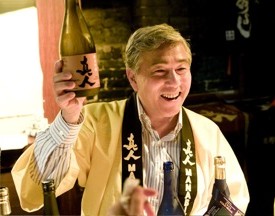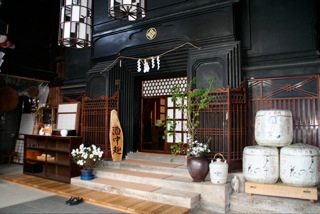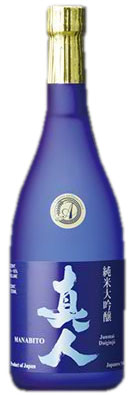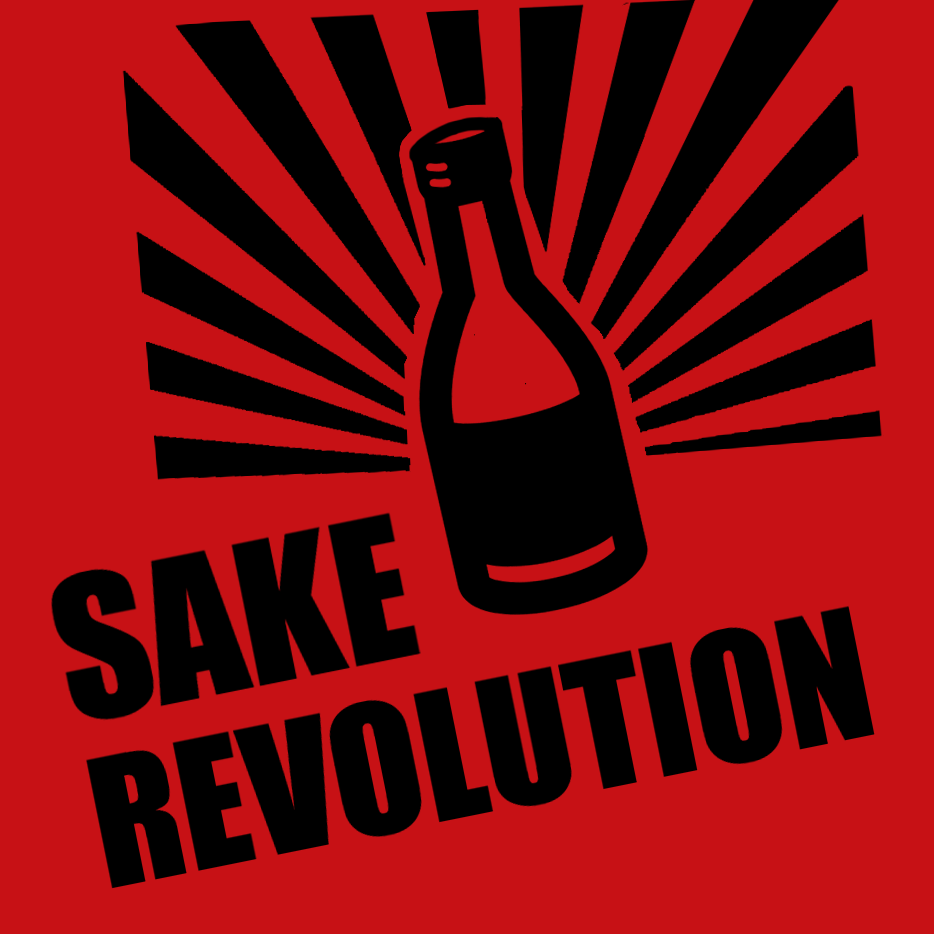Interview: Jouji Sato, Hinomaru Brewery
Mr. Sato President of Hinomaru Brewery
This was a really fun and unique opportunity to meet one-on-one with a sake brewer and ask just about anything. I had met Sato-san before at tastings and events, but this was my first opportunity to sit down and talk at length. Needless to say, I learned so much – Sato-san is a charming, engaging personality and his true love for sake and his native Akita Prefecture was easy to feel. He’s dedicated to making the best sake – and I think the career he had in banking, before taking over the family brewery, give him a special vantage point.
Timothy Sullivan: Do you have a message for American Drinkers of your sake?Jouji Sato:
The first thing I would say is I want them to try my sake!! Try Manabito Jumai Daiginjo and Manabito Kimoto Junmai Ginjo!Timothy Sullivan: How difficult was it to choose which of your sakes to import?
Jouji Sato: It was very difficult. It’s complicated because one company, one brand, one importer is the rule. We weren’t thinking so much about that when we first contemplated coming to the United States. In retrospect we may have been naive. I did not want to get behind the times.
When you export to a foreign country it’s a very complicated process. We actually tried our first exports 10 years ago. At that time, we would have never imagined that this New York Market for Sake would expand as it did.
Timothy Sullivan: 10 years ago?
Jouji Sato: Yes. 10 years ago I lost my Father suddenly. I was working as an investment banker and I had to suddenly quit the bank and take over the family brewery. At that time I never would have dreamt there would be any opportunity to travel internationally for sake business. When I left the bank, I thought for sure that was the end of my traveling – I actually put my passport away. So, this interview right here, right now – and what’s happening with the blossoming of the New York / USA sake market – I could never even have imagined this 10 years ago.
Timothy Sullivan: How important is the New York/American market? I hear from Brewers that sake sales are increasing in the US market, but is that just a drop in the bucket in regards to overall sales? or is this emerging American market a true help?
Jouji Sato: I think there are only one or two breweries for whom the tremendous investment to export to America has really paid off. For the most part, most brewers export well under 10% of their production to foreign markets. But I think a handful of brewers export up to 20% of their production. At Hinomaru Brewery we export 3% of our production – I’m aiming for 10%.
Timothy Sullivan: Do you brew your sake differently to be geared towards your local Akita market? …or geared towards the larger Japanese market? …or even geared towards foreign markets?
Jouji Sato: That’s a great question. Now, the sad thing is we can’t brew only for our local market anymore. We have to approach brewing our sake with a national market in mind, so we’re thinking of Tokyo, which is our primary market. In regards to the sake I sell here in the US and the sake I sell in Akita, Japan – I brew different products. I don’t know about otherbreweries but for me, it’s different products for different markets.For example, when my sake is tasted in New York, I want it to express and carry with it Japanese culture, so I’m bringing a very sophisticated sake to this market. I don’t have confidence that the sake that is enjoyed by locals in Akita would be successful in the New York or US market because it’s a hard sell in a market like Tokyo. On the other hand, the interesting thing is that the Americans are so open and receptive, that the likelihood of succeeding with even the local Akita style sakes is more of a possibility here than in Japan.
The food in Akita is very salty, so we have to make something for the local Akita market that is slightly sweet to balance with the local cuisine. We bring that sake to Tokyo or other parts of japan – it doesn’t fit their cuisine. But as we’re eating here in New York or other parts of the United States the Japanese restaurants are not serving “regional” food – it’s more “homogenized” in the US. And for us the greatest joy is the abundance of other cuisines in America for which sake is such an ideal match. Cheese dishes, seafood dishes, vegetarian dishes and the wonderful eclectic food here.
Timothy Sullivan: Since you brew a sake targeted to the American market, have you made any changes or adjustments to the profile of the sake so far?

Sato-san at Joy of Sake 2009
My sake is very unique in that both the Manabito Jumai Daiginjo and the Manabito Kimoto Junmai Ginjo are matured in air tight bottles at very low temperature at the brewery for a full two years. So they have two years to become exquisitely balanced, round, rich, smooth and stable. They hold up beautifully to whatever cuisine they encounter. Whereas a sake that is released young is going to be constantly effected by the variable temperatures. In brewing Manabito sake we aim for the perfect acidity levels that also help the sake remain stable regardless of the storage conditions in wine stores and restaurants. I’m confident that my sakes are incredibly delicious and incredibly stable.
Timothy Sullivan: Since you had years of experience as an investment banker in the business world outside of the brewery before becoming president, is there anything you changed in the production process to modernize things or did you stick with traditional brewing methods only?
Jouji Sato: We have an expression in Japanese… “There are things worth changing and things worth keeping the same.” Regardless of my desire to have my sake be popular in New York or Tokyo, there are things about the production of sake that cannot stray from tradition.
For example, the yeast. In my Grandfather’s day, it was the milling of the rice that allowed them to attain more delicate flavors. Nowadays there are many more types of yeast available. I don’t want to come out with a new sake every year using a different yeast. We use a limited number of yeasts that we traditionally used in the brewery. For me, the more important thing is how we handle the rice. So if you ask me, my joy comes from playing with the rice combinations… Earlier you asked me about regionality – that’s where I want to hold on to regionality because Akita is the Empire of Rice. I love using those rice blends to create elegant, aromatic yet stable sake. Having said that, I still enjoy the challenge of creating new things.
Timothy Sullivan: When was your brewery founded?
Jouji Sato: Hinomaru was founded in 1689. We are commemorating our 320th year. During the War we had to stop production for a little while – we had no rice for brewing.
Timothy Sullivan: How many brewery works do you have?
Jouji Sato: We have ten workers.
Timothy Sullivan: Only ten?!
Jouji Sato: At one time, we had 80 workers. Before the War, we were one of the largest breweries in the Tohoku region. The Second world war brought a lot of destruction to the area and to our brewery. So after the War, my father had to start from zero, or even less than zero, to rebuild.

Hinomaru Kura Building
320 years ago when the name was given our brewery was the pride of the country. But we have suffered the political consequences of the name “Hinomaru†is also what went down with the War. So after the Japanese lost the War, anything to do with the flag was indicative of our defeat. But my father didn’t want to give up the name and continued to brew sake under the name “Hinomaruâ€. Even within Japan just the Brewery name is part of the pride and the burden we carry. It should be the thing that gives us most pride, but when the name of your business is the name of the National Flag, it has a burden too.
Timothy Sullivan: Do you have any final message for your American consumers?
Jouji Sato: I’ve only been in the American market for just a year, so many people may have not had a chance to know I’m in the market. But I would love to ask the American Public – once you’ve had a chance to try my sake please tell me what you think of it! Because with that in mind, you can be sure that I’ll do my best to make the sake from my brewery that you will always love. When I sell my sake in Japan, inside the box is a little postcard. In America, there is not box, it’s just the bottle… so I can’t put a postcard in. But today we’ve got the internet! You can leave a comment at the ASPEC web-site: info@ aspec-sake.com or even with you Timothy at urban sake. I value every comment!
When you’re a brewery of our size – we’re the 5th smallest sake brewery in Akita – the most valuable thing we offer our customers is ourselves. Some sake may be cheap or new and different, but the most important thing in the long run is the Brewery..the people…. so when they taste Manabito sake, I want them to taste the brewery and the spirit of “manabito†or “true integrityâ€â€¦ and maybe a little bit of my quirky personality, too!
Timothy Sullivan: Thank you so much for taking the time to answer these questions… I feel like i’ve learned so much!
Jouji Sato: I could answer only because you asked. Thanks for asking!
Timothy Sullivan: Thank you, Sato-san!
Timothy with Sato-san




